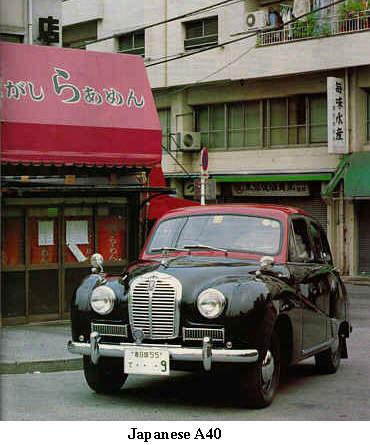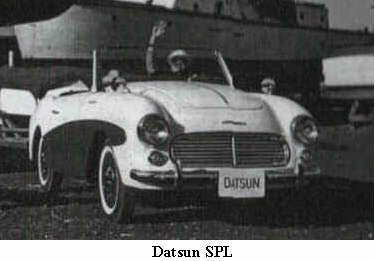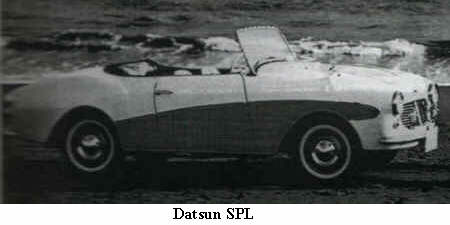
Sometime back I recall reading something from the US posing the question as to how similar the chassis and engine of the Datsun 240Z was to that of an Austin-Healey. I was a little surprised at the question as while there is a similarity with the concept of the two cars, long nose, engine out the front, driver near the rear axle you know that sort of thing but that’s about where it ends. However there is an interesting connection between Austin and Nissan in which the Austin-Healey does get a small but tenuous mention. Interestingly this connection goes right back to the 1930s and gets really serious during the important 1950s when Austin or BMC was the world’s largest exporter of motor vehicles.
Nissan itself has been in existence since 1915 when Satoro Hashimoto started the Kwaishinsha Company. Now I don’t know what his finances were like but he did enlist the financial help of three friends named Kenjiro Den, Rokuro Aoysma and Metaro Takeuchi. Now Mr Hashimoto being an honourable gentleman named his new cars after his three benefactors, but using the first initials of their surnames DAT. During the 1920s following a merger the cars became known as Datson and changing again in 1932 to Datsun. The company was greatly affected by the Great Depression and was under the control of a holding company called Nippon Sangyo of which Nissan is an abbreviation.
Datsun – Austin Lookalike
During the mid 1930s it gets a little cloudy as I have read a number of contradictory reports about one particular car Nissan was producing that was very similar to the diminutive Austin 7. One report states that Nissan made the Austin 7 under license as American Bantam did in the US and BMW in Germany. Other reports state that the Datsun was nothing short of a copy of the Austin. It goes as far as to say that Austin imported an example to the UK for a close inspection to see if any patents were infringed, which they weren’t. Interestingly there were plans to export a large number of the Datsun – Austin 7 lookalikes to Australia in 1935, however after just 24 reached our shores political pressure put a stop to it. Perhaps this was the first example of the Japanese automotive invasion?
You would appreciate that I need to skip now to the late 1940s and early 1950s, as all the players concerned were involved in more serious matters. Anyway after WW2 occupying allied forces in Japan prohibited car production in that country and Nissan and other Japanese vehicle manufacturers fell way behind the rest of the world. It wasn’t to be until 1948 when the go ahead was given to produce new vehicles. However it didn’t take Nissan long to realise that the cost to produce a brand new car was prohibitive. There was consideration to a linking with Volkswagen but it didn’t seem to be the politically correct step to take so close after the war.
In 1954 the President of Nissan proudly announced that it had reached agreement to produce Austin products under license in Japan. Apart from the Austin 7 connection this wasn’t the first time Nissan had sought overseas assistance, as back in 1935 a technical agreement had been reached with US manufacturer Graham-Paige which involved the shipping of an entire production line to Japan.
Austin/Nissan A40
The arrangement was extremely generous with Austin provide every assistance possible including materials, drawings, specifications and importantly patented technology that the Japanese company was able to use in its other products. From then until 1960 Nissan produced 21,589 A40 and A50 saloons and Cambridge station wagons using the BMC ‘B’ Series engine design. While doing so Nissan gradually built up local content.
No doubt a lot of us remember the sixties and closely looking at the range of small-engined Datsun vehicles at the time and noticed the similarity between the engines and BMC ‘B’ series engine. Back then I didn’t realise the connection. Nissan actually continued to produce cars with the ‘B’ Series based engine right up to 1972.
Now it starts to get really interesting as during this time Nissan has consistently produced an open car in its range. Their first car was called the DC-3 that was nothing like the famous aircraft of the same name but more like a Singer tourer or stumpy more upright MGTD and wisely was based on the chassis of the sedan at the time.
Austin-Healey Lookalike
Apart from the obvious Austin/Nissan vehicles the English influence on the Japanese manufacturer was prevalent with the 310 sedan looking as if it would look quite at home driving down an English laneway. Using the sedan chassis Nissan then produced two sports cars that us Austin-Healey owners really have to look twice at. They were the SPL212 and SPL213, which Nissan christened the Fair Lady, a name that has remained to Nissan sports cars to this day. Yes the name did come from the film My Fair Lady with Audrey Hepburn (Sigh!) as Nissan president Katsuji Kawamata was quite taken with the film. I was amazed the first time I saw photos of the 212/213 due to the similarity with the Austin-Healey. However they actually very different motor cars being powered by the ‘B’ Series derived 1,129cc four cylinder and curiously the bodies were in fibreglass. Nissan had hoped for considerable success with these cars and actively exported them including to the US in 1958, but unfortunately the model was not a sales success.
However it was a sign of things to come as while the SPL212/213 was unsuccessfully launched in the US Nissan engineers were working on a new sports car called the SPL310. This vehicle was launched as the Fair Lady 1500 in the 1961 Tokyo Motor Show and in New York in the northern spring of 1962. This car and its successors went on to be sold the world as the 1600 and 2000 until 1970. Many have said that the 1500 Fair Lady was a Japanese copy of the MGB, but as the ‘B’ was launched in September 1962 after being in production since July of that year I have my doubts.
There are two interesting asides here; one was the entry on the scene of Albrecht Goertz and his design of the pretty Nissan Sylvia coupe. Goertz was a German count who had worked for Studebaker on the 1953 Starliner who then returned to Germany to work for BMW. He was responsible for the highly considered BMW 507 V8 sports car and was later heavily involved in the design of the Porsche 911. Later followed the stunning Toyota 2000GT with its Yamaha built DOHC straight six. However he was to feature very strongly indeed with Nissan a year or so later. The second aside was that the engine in the Datsun 1500 was not derived from the BMC ‘B’ series but a new design that was also fitted to Nissan sedans of the time including the highly uninteresting Nissan Cedric. Imported to Australia and so name after a BMC engineer as a sign of Nissan’s appreciation of the British company’s assistance.
Japan Bound 3000s
I can’t vouch for this but back in the early 1970s not long after I bought my first 100 I heard that there were two BJ8s imported new into Japan and both were bought by the Nissan Motor Company. Over the years I have heard the same story from completely different sources so I am fairly certain of its accuracy. All of which leads me to speculate that Nissan must have used them to study while designing their highly successful 240Z sports coupe, also called Fair Lady in Japan. What I do know was that the 240Z was designed by the same Albrecht Goertz and unlike the Austin-Healey did not have a proper chassis or in other words was of monocoque construction. As I said before the 240Z and later Z cars certainly have the same idea as the Big Healey but the construction is very different.
Now for the 240Z’s single overhead camshaft straight six engine, which
as the numbers imply was a 2.4litre, which eventually grew to be a three
litre. Unfortunately for our story this engine does not have its roots
in any British design at all, in fact it is more then likely to have come
from a German Mercedes Benz design.
Back in early 1960s the Japanese company Prince produced range of sturdy four and six cylinder motor cars. Prince was very much ‘middle-of-the-road’ within the world of Japanese motor vehicle manufacturers. Concerned with their image Prince embarked on the production of a new model that would be suitable for both the street and track. Prince obtained the build rights of a single overhead camshaft straight six engine and did what any respectable hot rodder would do. They cut an example of their current four-cylinder Skyline sedan at the firewall and welded in eight inches. Now the six-cylinder engine fitted perfectly and then to obtain maximum horsepower from the engine triple duel throat Weber carburettors were fitted. So was born the Prince Skyline GT that were imported in some numbers to Australia, New Zealand and South Africa, all right hand drive countries as is Japan.
A team was entered into the 1964 Japan Grand Prix Road Race in the days before open wheelers and came in second behind a late entry works Porsche 904 GTS. So successful was the new Prince that it made Nissan sit up and watch. Eventually the much larger Nissan bought out the smaller Prince and that was the last we saw of their cars. However the Prince engine lived on in the 240Z and proved to be a highly successful power unit.
There was a small connection between Healey and Nissan plus an even bigger one with Austin. I suppose what it does show is that the Automotive Industry world was small indeed.